
The third collection of endemic plants from inaccessible cliffs in the region was conducted using Mamba drones, a combination of two devices previously used in Hawaii and for the first time operating in Europe.
During the prospecting carried out this week, collections were made on Monday and again today, with one of them indicating a new species, according to the researchers.
Today’s operation, led by Ben Nyberg, a scientist at the Hawaii Botanical Garden who helped develop this technological innovation, started shortly after 10:00 in the parish of Curral das Freiras, in the heart of Madeira Island.
An initial survey was conducted with a regular drone, and at 10:44, the Mamba system, consisting of two drones—one larger and one front-facing with tongs for gathering—came into action.
In the initial flights, the plant fell from the drone. However, around an hour later, the researchers celebrated the successful retrieval of ‘marcetella madeirensis’ by the equipment piloted by Ben Nyberg.
“It’s an endemic plant of Madeira Island, exclusive. It is a plant from the south of the island, which only exists in these terraces in the ravines. It belongs to the rose family […] and has separate sexes, female and male, which increases the complexity of its conservation because, obviously, if they don’t have males and females together, we won’t get seeds, so it’s a complex issue,” explained Professor Miguel Sequeira, coordinator of the Botany Group at the University of Madeira.
The group will supply the seeds to the Institute of Forests and Nature Conservation, which will “store the fruits and seeds with genetic reserve,” he indicated.
The Botany Group will perform their usual tasks with rare plants, added Miguel Sequeira: “We will collect some leaves in better condition and use them to extract DNA. We will store this DNA for future studies on population genetics to see if it continues to exist and to determine the diversity patterns within and outside the populations.”
Professor Sequeira highlighted that on Monday, for the first time in Madeira and Europe, “they were able to go to a cliff without any risk to anyone […] to collect a seed.”
In 2022, the research team had already identified a population that “seemed peculiar,” which they attempted to reach on foot unsuccessfully. However, on Monday, they successfully collected it near Cabo Girão.
Called ‘Cheirolophus,’ it is a unique genus in Madeira, and “it is very likely that it is indeed a new species,” which now requires confirmation through genetic and morphological studies. This process takes no less than a year.
Highlighting the significance of this project for Madeiran biodiversity, Miguel Sequeira emphasized that plant collections on cliffs have “already resulted in the conservation of some species” in Hawaii, “because it allows, for example, taking cuttings from species that only exist in ravines and could not be reached before, or collecting fruits and seeds” to later grow “new plants which could eventually be reintroduced into the wild.”
Ben Nyberg also noted that the two regions face many similar challenges and are composed of “many rare and endemic plants and many cliffs.”
“The landscape is similar, but the plants are completely different. There are many unique species that only occur here, so the work is similar, but it is important to do it here as well,” he emphasized.
Nyberg recognized that piloting this dual-drone system, with two controllers containing 10 buttons each, is complex, pointing out that it is an ongoing learning process and “few people in the world” can operate it.
“It was developed solely for this purpose, and not many people are engaged in this type of work,” he reiterated.
The initiative was organized by the Botany Group of the Life Sciences Faculty of Madeira, coordinated by Professor Miguel Sequeira, in partnership with the Hawaii Botanical Garden, and had the collaboration of the Operational Command of Madeira and the Institute of Forests and Nature Conservation.
A total of three plants were collected, two of them on Monday at Cabo Girão and Ribeira Brava. On the remaining days, prospecting was conducted to enable future flights to reach more species in the region.




